The Stream, October 6, 2020: MI Clean Water Plan Aims To Upgrade Michigan Water Infrastructure
The Global Rundown
Michigan Gov. Gretchen Whitmer creates a multi-million dollar plan to improve the state’s water quality. Storm Alex wreaks havoc in France and Italy. A number of waterspouts are expected to arise in the Great Lakes this week, according to the International Centre for Waterspout Research. An unknown source has polluted beaches in one of Russia’s most remote regions. Experts say a new treaty is needed between the United States and Mexico amid water disputes in the Rio Grande.
“If the government sends our water to the United States, we will have less than half of what we need for the next year. That will affect fourteen towns and half a million people.” – A walnut grower in the Mexican state of Chihuahua that took part in protests at the La Boquilla dam. Protests erupted at the dam last month over a 1944 agreement between the United States and Mexico that entitles the U.S. to 350,000 acre-feet of water from the Rio Grande every year. Under the treaty, Mexico is allowed to miss sending it’s annual share as long as it sends 1.75 million acre-feet within five years. It has missed that five-year deadline four times. Mexican president Andrés Manuel López Obrador has insisted that Mexico will comply with the order, but farmers in Chihuahua say compliance now will starve them of irrigation water needed to support their livelihoods. Farmers have occupied the La Boquilla dam since September in an attempt to keep the water on their side of the border. There’s no easy solution, according to Luis Ribera, the director of Texas A&M University’s Center for North American studies. Ultimately, Ribera said, the U.S. and Mexico need to come up with a new way to share the water that is more suited for today’s agricultural landscape. Texas Monthly
In context: HotSpots H2O: Conflict over U.S.-Mexico Water Treaty Escalates as Farmers Take La Boquilla Dam
Latest WaterNews from Circle of Blue
HotSpots H2O: Wildfire Threaten Cheyenne Water Supply – The Mullen Fire, which has spread through more than 147,000 acres of Colorado and Wyoming forest in the past two weeks, reached the southern edge of the main drinking water source of Cheyenne, the Wyoming capital. Protection of Rob Roy Reservoir is a major priority, city officials say.
What’s Up With Water— October 5, 2020 — This week’s episode covers a national initiative for more efficient irrigation practices in Egypt, the UN human rights expert calling on Columbian officials to cut mining pollution during the pandemic, the Army Corps of Engineers who gave a contested long-distance natural gas pipeline permission to cross streams in the eastern United States and a severe drought in New Hampshire that is causing hundreds of household water wells to go dry.
By The Numbers
$500 million The budget for a new plan rolled out by Michigan Gov. Gretchen Whitmer last week to upgrade drinking water and wastewater infrastructure in the state. The MI Clean Water initiative includes programs to replace lead service lines, remove chemical pollutants and will create a budget for local governments to apply for grants or loans to improve water treatment systems. The plan has been praised from both sides of the aisle after the discovery of lead contamination in Flint and chemical compounds known as PFAS in several cities that shed light on long-standing water quality issues in Michigan. AP
20 The number of people missing, in addition to four who were found dead, after flash floods from Storm Alex hit south-eastern parts of France and north-western parts of Italy over the weekend. The French city of Nice and its surrounding area saw almost a year’s rainfall in less than 12 hours over the weekend before moving into northern Italy. France has declared the region a natural disaster zone and officials in Italy described the flooding as “historic.” BBC
Science, Studies, and Reports
Warm water, cold air and significant wind-flow have created the perfect environment for a series of waterspouts to develop on the Great Lakes this week. The International Centre for Waterspout Research has predicted that the chance for waterspouts will increase drastically on Thursday and Friday as air temperatures decrease, with the highest chances occurring in Lake Superior and Lake Michigan. Waterspouts can produce 100 mph (160.9 kph) winds in the funnel’s circulation and can occasionally come on land, but typically dissipate after hitting the shoreline. MLive
On the Radar
Oil products and phenol were found in waters along the beaches of Kamchatka, one of Russia’s most remote regions. The water was tested after dead sea creatures washed up onto shore over the weekend and after months of reports of swollen eyelids, vomiting and the contraction of fevers and rashes from locals. Local officials have said an investigation into the source of the contamination is ongoing. BBC
Jane is a Communications Associate for Circle of Blue. She writes The Stream and has covered domestic and international water issues for Circle of Blue. She is a recent graduate of Grand Valley State University, where she studied Multimedia Journalism and Women, Gender and Sexuality Studies. During her time at Grand Valley, she was the host of the Community Service Learning Center podcast Be the Change. Currently based in Grand Rapids, Michigan, Jane enjoys listening to music, reading and spending time outdoors.






Leave a Reply
Want to join the discussion?Feel free to contribute!